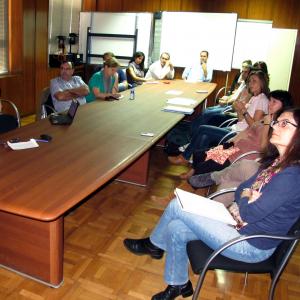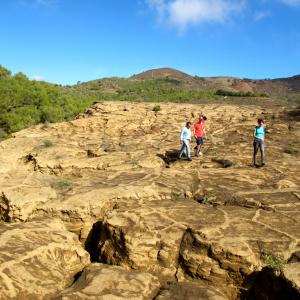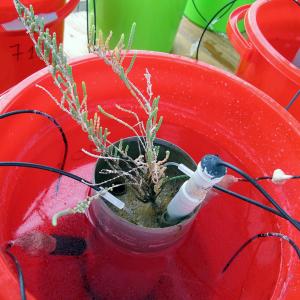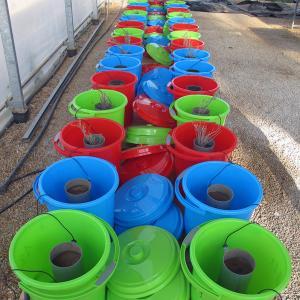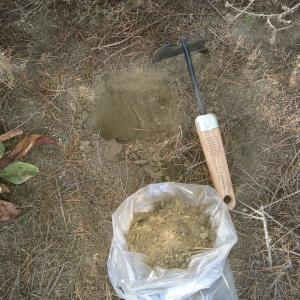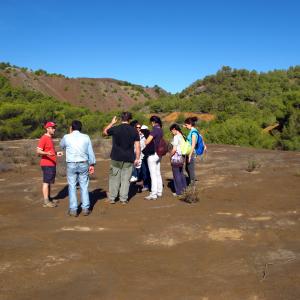
Ministerio de Economía y Competitividad of Spain
2014-2017
UPCT, University of Almería, AGR-ACONDICIONAMIENTO TARRASENSE – LEITAT
This is a coordinated project that aims to evaluate the effect of biochar from pruning trees and sewage sludge on the fate and toxicity of mine wastes. The project comprises three sub-projects developed by Spanish research centres: Universidad Politécnica de Cartagena (subproject CGL2013-49009-C3-1-R), Universidad de Almería (subproject CGL2013-49009-C3-3-R), and Acondicionamiento Terrasense–LEITAT (subproject CGL2013-49009-C3-2-R), with the collaboration of the VU University, Amsterdam.
The overarching aim of this project is to assess the toxicity of mine tailings from old mine exploitations before and after amendments with different types of biochars. To achieve this objective, this study will address the following aspects:
* The viability of the soil seed bank from the mine tailings area will be studied, and further recommendations pointing at a recovery of the vegetation cover will be established.
* Column experiments with acid and basic mine wastes will be set up. The treatments tested include additions of different types of biochars, presence/absence of plants, and changing hydric conditions, in order to ascertain the fate of metal(loid)s. The pH and redox potential (Eh) will be regularly monitored, and soil pore water and lixiviate samples extracted from the columns to determine their metal(loid) concentrations before and after the amendments.
* The biogeochemical mechanisms implied in the role of biochar to immobilise metal(loid)s will be studied by means of specific equilibrium trials with mixtures mine wastes vs. biochar.
* The effectiveness of the treatments to reduce the toxicity of the soil pore water, lixiviates and the solid phase will be evaluated by means of a battery of ecotoxicity tests which include seeds germination, plantlets development, genotoxicity, and earthworms and enchytraeids survival and reproduction.
* At the end of the experiment, the plants will be collected from the columns and concentrations of metal(loids) in leaves and roots analysed to evaluate the effect of biochar on its absorption and translocation. In addition, the stress of the plants will be assessed by physiological markers.
* Finally, a sequential extraction of soil metal(loid)s will be performed in order to determine how the different treatments influenced its speciation and to relate it with its fate, bioavailability and toxicity.
The risks of toxicity by metals/metalloids due to mining wastes pollution take place in the mine tailings, but also in lowland areas such as wetlands due to the erosion of the tailings and the transportation of wastes to these topographically depressed positions. In this Project, we work in field and experimental conditions, performing toxicity tests with seeds, seedings, young/adult plants and soil invertebrates. We study the soil seeds bank of mining polluted areas and we will determine what influence may have the toxicity in the viability of these seeds in order to establish some recommendations allowing the recovering of the vegetal cover of these degraded lands. We develop some experiments to evaluate the effect of biochar from urban solid wastes and sewage sludge on the reduction of the toxicity risks by metals/metalloids. We work in columns with acidic and basic mining wastes, with and without biochar, with and without plants, and with variable hydric conditions. We check the pH and Eh conditions as well as the concentrations of soluble metals/metalloids. Regularly, we extract the water from the soil solution and lixiviates, and we will test its toxicity and genotoxicity on seeds germination and plantlets development. At the end of the experiment, we will remove the plants from the columns and we will analyse leaves and roots in order to know the effect of the amendments on the absorption and translocation of contaminants from roots to leaves. In addition, we analyse its stress by physiological markers. All these analyses will allow us to evaluate the effectiveness of biochar on the toxicity reduction of both mining wastes and the soils polluted by them.
We perform also ecotoxicity tests with the mining wastes and the extracted soil solutions at the beginning and the end of the columns experiments in order to evaluate how the toxicity is influenced by the treatments assayed. We use different soil invertebrates with different exposure routes to the contaminants in order to estimate the pool of bioavailable metals in the solid and liquid phases of the mining wastes, before and after the treatment with different types of amendments. The performance of these bioassays with different types of mining wastes and with different hydric conditions will allow us to evaluate the effectiveness of the amendments in different exposure scenarios. Altogether, these data will allow us to evaluate the effectiveness of biochar on the toxicity reduction of both mining wastes and the soils polluted by them. At the end of the experiment, we will also perform a metal sequential extraction procedure in order to know how biochar may modify the way that these metals are present in the mining wastes and how these forms affect their bioavailability and the health of the ecosystem.
Definitely, we try to amend mining wastes with organic wastes whose disposal involve, in many cases, both an economic and an environmental and social problem. The valorisation and reutilisation of these wastes is a challenge that numerous efforts are engaged it, including ours, with the final purpose of transforming and changing them from a problem to a promising resource. In the case of organic wastes, its use will contribute also to ameliorate the functionality of the polluted receiving environment, and in the case of biochar to the sequestration of carbon, so important in the current climate change context.
Papers JCR
Álvarez-Rogel, J., Tercero, MC, Conesa, H., Párraga-Aguado, I., González-Alcaraz, MN. (2018). Biochar from sewage sludge and pruning trees reduced porewater Cd, Pb and Zn concentrations in acidic, but not basic, mine soils under hydric conditions. Journal of Environmental Management 223, 554–565. ISSN: 0269-7491. https://doi.org/10.1016/j.jenvman.2018.06.055.
Final study projects
Metal mobility assessment for the application of biochar amendments in acidic and neutral pH mine tailing soils under variable moisture conditions. Student: Brittany Laing (Erasmus student from UHasselt/KU Leuven). Master’s degree in Advanced Techniques for Agricultural Alimentary Research and Development. 2016.
Efecto del biochar sobre la dinámica de metales solubles en residuos mineros sometidos a condiciones de hidromorfía variables. Student: Juan Sánchez Martínez.Master’s degree in Advanced Techniques for Agricultural Alimentary Research and Development. 2015.
Extractability and speciation of metals in mine wastes amended with municipal solid wastes (MSW) and biochar. Student: Eline Goldstein (Erasmus student from the UC Leuven, Limburg). Master’s degree in Advanced Techniques for Agricultural Alimentary Research and Development. 2015.
Comportamiento de las semillas de dos especies halófitas en soluciones acuosas extraídas de residuos mineros: efectos del biochar para mejorar la respuesta germinativa y los primeros estadíos del desarrollo de plántulas. Student: MªDolores Cañavate Sastre. Titulación: Grado en Ingeniería Agronómica. Nota: Sobresaliente, 9,5. Convocatoria: Septiembre 2015/2016.
|
Caracterización de la germinación y el vigor de las plántulas de Piptatherum miliaceum en diferentes suelos y sustratos relacionados con los suelos mineros. Directores: Juan José Martínez Sánchez Sánchez (UPCT) y Javier Velázquez Saornil (Universidad Católica de Ávila). Trabajo realizado en la UPCT pero presentado en la Universidad Católica de Ávila. Student: Vicente Sánchez Roca |
CONGRESESS
José Álvarez-Rogel, Inés García; Fernando del Moral; Héctor M Conesa; AA Calderón; MA Ferrer; MC Tercero; Isabel María Párraga-Aguado; JA Sánchez; S de Haro; María José Delgado; Verónica González; José A Franco; Cornelis AM van Gestel; María Nazaret González-Alcaraz. The MINETOX project: a multidisciplinary approach to assess the effects of biochar on the fate and toxicity of mine wastes under changing hydrology using bioassays with plants and soil invertebrates. PÓSTER. SETAC Europe 25th Annual Meeting. Barcelona (España). May 2015.
José Álvarez-Rogel, Juan Sánchez Martínez, María del Carmen Tercero Gómez, Héctor Miguel Conesa Alcaraz, Isabel Párraga-Aguado, M. Nazaret González-Alcaraz. Effects of biochar on the dynamic of metals in soils polluted by mining wastes under changing hydric conditions. SETAC Europe 26th Annual Meeting. Nantes (Francia). May 2016.
José Álvarez-Rogel, María del Carmen Tercero Gómez, Héctor Miguel Conesa Alcaraz, Isabel M. Párraga, M. Nazaret González-Alcaraz. Título: Phytomanagement of eutrophic wetlands polluted by mine wastes: the role of the biogeochemical processes. PÓSTER. SETAC Europe 26th Annual Meeting. Nantes (Francia). May 2016.
J. Álvarez-Rogel, H.M. Conesa Alcaraz, I. Párraga-Aguado, O. Martínez Oró, M.C. Tercero Gómez, A. Peñalver Alcalá, F.J. Jiménez-Cárceles, J.J. Martínez Sánchez, M.N. González-Alcaraz. Ecological impacts and ecosystem response in an old mining area of SE Spain: learning lessons for phytomanagement. PÓSTER. SETAC Europe 27th Annual Meeting. Bruselas (Bélgica). May 2017.
M.N. González-Alcaraz, J. Sánchez Martínez, M.C. Tercero Gómez, I. Párraga-Aguado, O. Martínez Oró, M.J. Delgado, A. Peñalver Alcalá, H.M. Conesa Alcaraz, J. Álvarez-Rogel. Plant growth and changes in redox potential modulate the effects of biochar for improving wetland soils polluted by mine wastes. PÓSTER. SETAC Europe 27th Annual Meeting. Bruselas (Bélgica). May 2017.
J. Álvarez-Rogel, M.J. Vicente, M.D. Cañavate Sastre, J. Sánchez Martínez, M.C. Tercero Gómez, H.M. Conesa Alcaraz, M.N. González-Alcaraz. Biochar addition improves edaphic conditions and favours root elongation and biomass production of Sarcocornia fruticosa growing in acidic mine wastes. PÓSTER. SETAC Europe 27th Annual Meeting. Bruselas (Bélgica). May 2017.
Juan Sánchez Martínez, María del Carmen Tercero Gómez, M. Nazaret González‐Alcaraz, Héctor Miguel Conesa Alcaraz, Isabel Párraga‐Aguado, José Álvarez‐Rogel. PÓSTER. V Congreso de la Naturaleza de la Región de Murcia‐II Congreso del Sureste. Murcia (España). 25‐28 Nov 2015.

